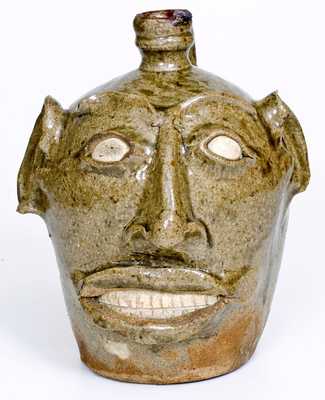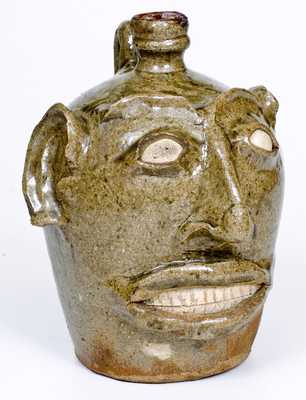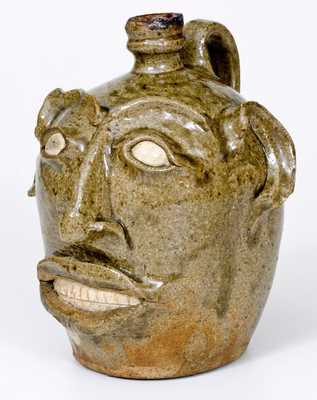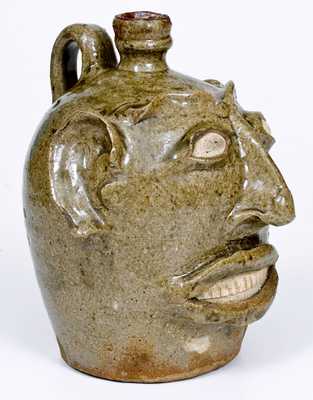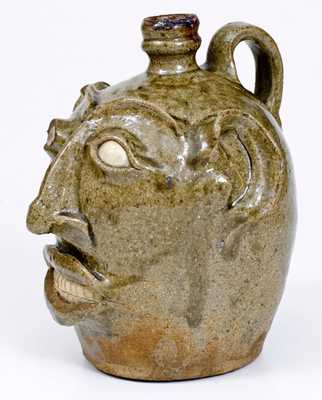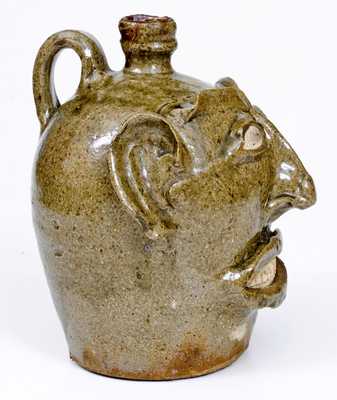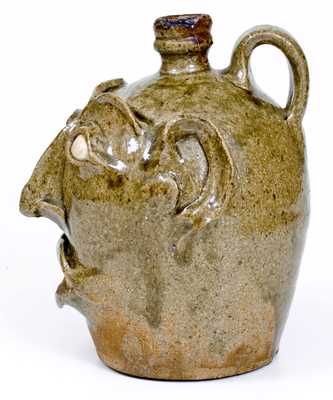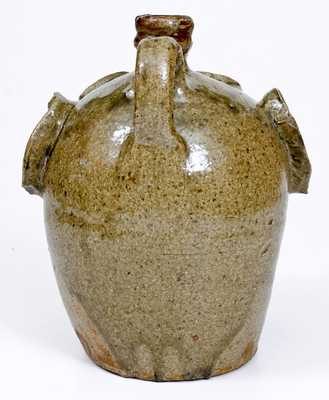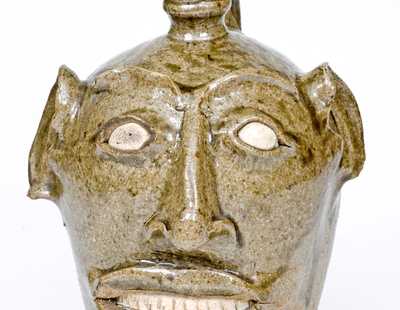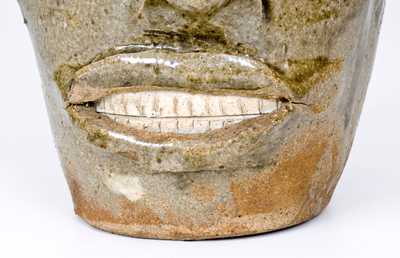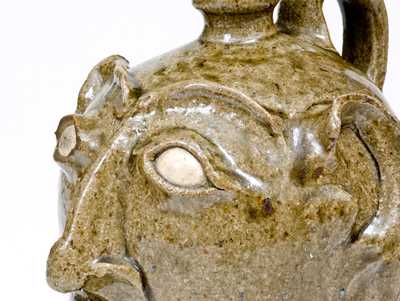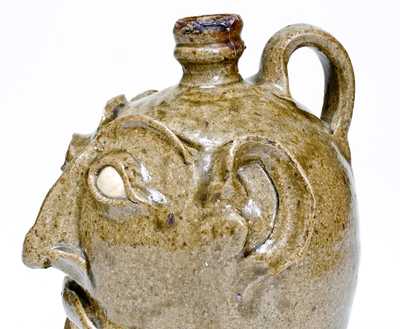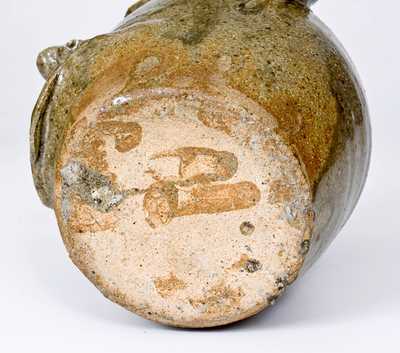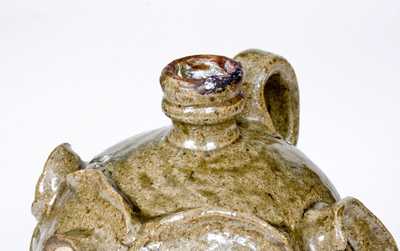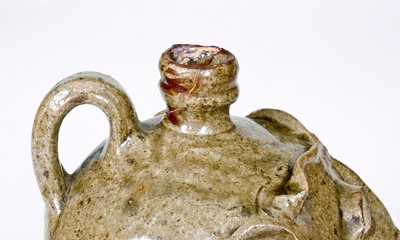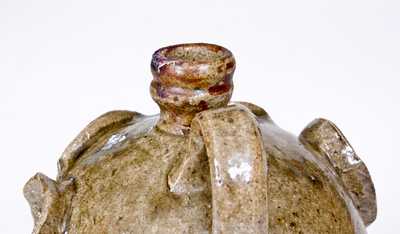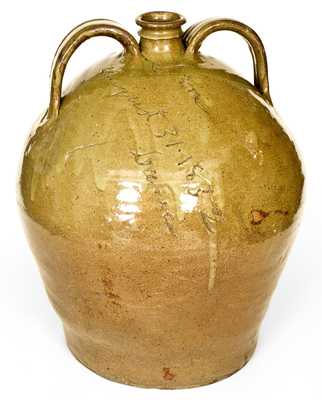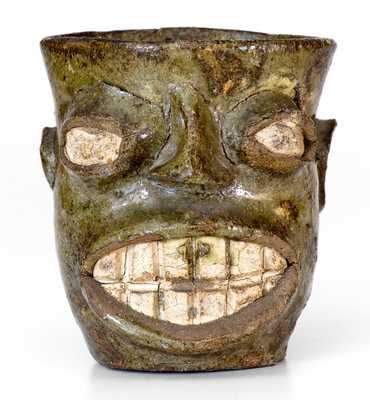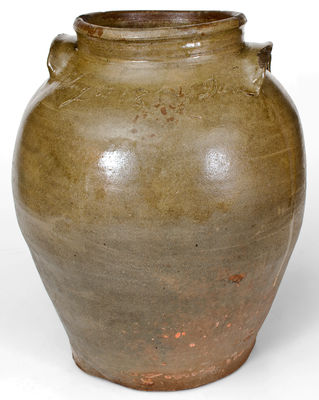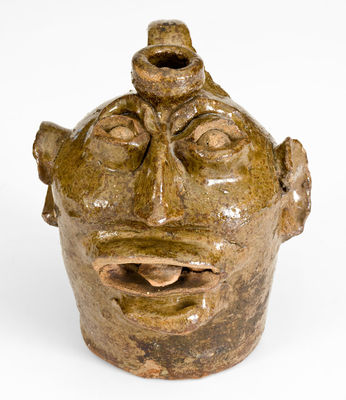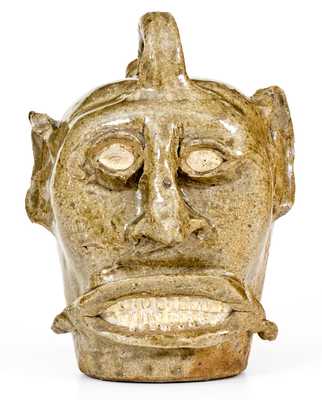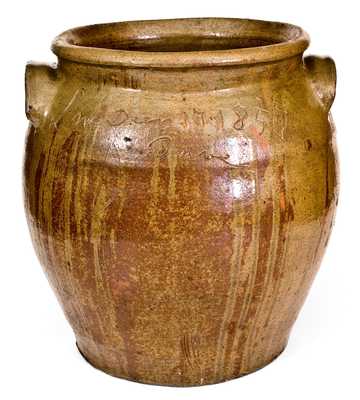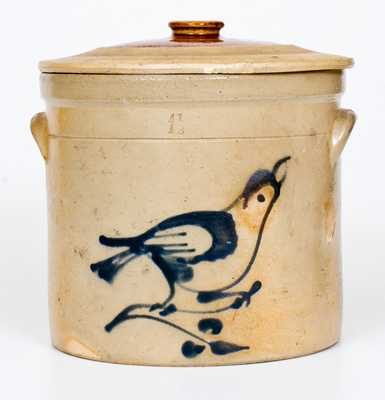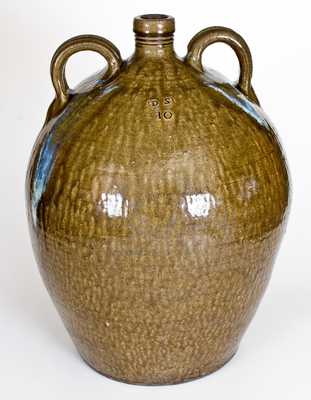Rare and Important Large-Sized Stoneware Face Jug, Edgefield District, SC origin, circa 1845-1865, ovoid jug with finely-formed, stepped spout and applied strap handle, the front decorated with an applied clay face, including bulging kaolin eyes set within elliptical lids, conjoined arching eyebrows, prominent nose with pinched nostrils, open mouth with well-executed, flattened lips and incised kaolin teeth, and large ears with tragi. Sides of jug lightly-depressed to create the figure's cheek and jaw structure. Surface of jug coated in a beautiful, light-green alkaline glaze with runs to shoulder and right side, as well as lighter application to base, creating an appealing mottling to surface. Among the finest Edgefield face vessels to come to auction, this recently-surfaced work features exceptional size, sculpting, and color. While the majority of Edgefield face jugs stand roughly five to six inches in height, this example measures 8 3/4" tall with a capacity of one-half-gallon to three quarts. It relates in style to a small, but important, group of face jugs from a currently-unidentified school or maker. Among this group is a monkey jug, incised "Joe Kirksey", illustrated on p. 81, fig. 3.10 of Cinda K. Baldwin's book, Great and Noble Jar, and currently in the collection of the High Museum of Art in Atlanta, GA. A second example is illustrated on the back cover of Great and Noble Jar, and currently resides in the collection of the Museum of Fine Arts, Boston. The finely-shaped spout on the example to be auctioned is often linked to earlier Edgefield potteries of the 1840-1855 time period. Among the most significant discoveries in Edgefield stoneware of the past decade. Provenance: A recently-discovered example, found in the estate of a descendant of Samuel W. Bridgham (1775-1840), the first mayor of Providence, Rhode Island. Possible early owners of the jug include any of Bridgham's three sons, Samuel (1842-1915), Joseph (1845-1915), who served during the Civil War in Company K of the Seventh Regiment of the New York State militia, or William (1849-1916). A reglued wedge to reverse side of spout, along with a shallow 5/8" flake to top of spout, with crude, old plaster repair. A shallow flake to one ear. H 8 3/4".
Some additional important notes regarding provenance:
While this jug is noteworthy in its size and expressiveness, it additionally holds strong historical significance in its provenance. Mysteries surrounding this iconic Southern form abound, due in part to a lack of history of ownership for individual examples. Most are simply found along the way by keen-eyed collectors or dealers, some in the South, but many in the Northeastern United States. A handful of the better-provenanced examples include those purchased in 1969 by New York folk art collector, John Gordon, from Helen Eve, a descendant of Colonel Thomas Davies, owner of the Palmetto Fire Brick Works in Bath, SC, during the 1860s. (This group of face vessels, sold at Christie's in 1999, had previously been acquired by Eve's son, William Raiford Eve, before World War II from an African-American community located between Aiken and Langley, South Carolina.) A small number of other examples carry provenances as museum donations, some gifted as early as the first decade of the 20th century.
This jug, however, offers us a rare glimpse into possible ownership dating back to the third quarter of the 19th century. Our initial provenance on the jug is listed in this catalog as:
"A recently-discovered example, found in the estate of a descendant of Samuel W. Bridgham (1775-1840), the first mayor of Providence, Rhode Island. Possible early owners of the jug include any of Bridgham's three sons, Samuel (1842-1915), Joseph (1845-1915), who served during the Civil War in Company K of the Seventh Regiment of the New York State militia, or William (1849-1916)."
New details have brought to light the name of the estate in which the jug was found, that of Clive W. Bridgham (1951-2018) of Barrington, RI. The sale of Bridgham's estate, which occurred in June of this year, included a veritable time-capsule of family pieces dating to the 19th century. Among these items was this jug, uncovered in a closet. Bridgham's ancestry, as previously noted in our catalog, included Samuel W. Bridgham (1775-1840), the first mayor of Providence, RI, whose fire bucket was also sold in the estate sale.
Samuel W. Bridgham had a nephew, Capt. Thomas Paine (1786-1859), who possibly brought the jug from its home state to Rhode Island. An excerpt from the "Manufacturers' and Farmers' Journal," Providence, RI, Nov. 14, 1859, p. 1, reads as follows:
Capt. Thomas Paine, whose death was noticed yesterday, was a gallant officer of the American navy, and a genial and kind hearted man. He was born, we believe, in Massachusetts, but for many years lived in Savannah and in Charleston. He was a nephew of Samuel Bridgham, the first mayor of Providence, and he occasionally visited this city, where many of our readers remember him. We shall doubtless find in the Savannah or Charleston papers a memoir of his life, and a fitting tribute to this worth.
The journal's passage not only draws a familial connection between South Carolina, the state in which the jug was produced, and Rhode Island, the jug's ultimate resting place; it also indicates a possible means by which the jug traveled to New England, as Paine "occasionally visited [Providence]," presumably as a ship's captain.
A second possible owner was Paine's son, Edward Tatnall Paine, (1824-1908), a prominent Charleston cotton farmer and rice planter. His obituary in The Atlanta Constitution, August 23, 1908, reads:
Captain Edward Tattnall Paine, the oldest lineal descendant of Governor Landgrave Smith, of South Carolina, died at the residence of his son, Thomas B. Paine, at East Lake, Friday night at 12 o'clock. Captain Paine came to Atlanta two weeks ago to pay a visit to his son, and had been here only a few days when he became ill. Captain Paine was 85 years of age and was born
in Charleston, S. C. His father was Captain Thomas Paine, of the United States navy and his mother was Mary Lucia Bellinger, a grand-daughter of Governor Landgrave Smith. Before the war he was a cotton factor and a large rice planter, and for many years he was captain of the famous Charleston Light Dragoons. He was one of the few surviving members of the old St. Cecelia Society of Charleston. He was married to Miss Julia Faber Beckley, of Charleston, a grand-daughter of Charles Desel, of the old Huguenot family of that name, one of the oldest families in South Carolina.
Edward Tatnall Paine's obituary indicates he was linked to Charleston High Society by marriage and membership in at least two organizations: the Charleston Light Dragoons, an exclusive militia of privileged Charlestonians, which dated back to the 18th century and was ravaged by Grant's troops at Richmond, and the St. Cecelia Society, which began as a private concert organization, but, by 1820, had essentially become a social club for South Carolina's elite.
Paine was thus connected to two opposing ends of the social spectrum. On one end, as a grower of cotton and rice, he regularly interacted with African-American slaves, a group popularly linked to both the manufacture and ritualistic use of Edgefield-made face vessels. On the other end, he fraternized with Charleston's wealthiest and most influential through various social institutions, where a piece related to rural African-American culture could be viewed as a curiosity or visually-engaging object. Either association is a possible means by which this object could have been acquired. Paine's interactions with Northern relatives later in life could easily explain the jug's final resting place in Rhode Island.
Our upcoming sale offers a rare opportunity to acquire one of the finest Edgefield face jugs to ever come to auction, a work symbolic of a rapidly-growing fervor for Southern-made decorative arts. As an auction house interested in the history of pieces as much as their artistic value, we have added this new-found research to expand the narrative of this remarkable find.

